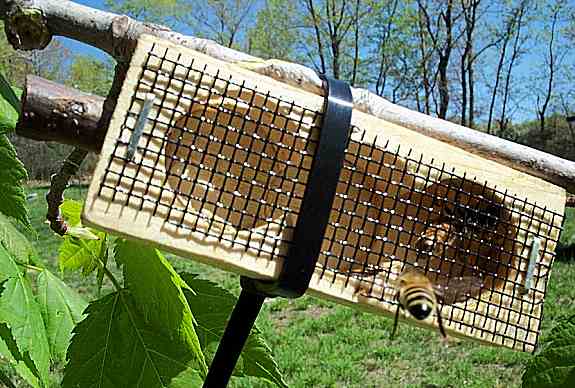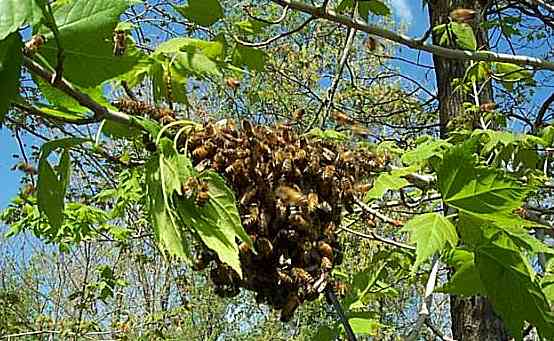|
|
|
|---|
|
|
Demonstration Of How Fast Swarms Can Find A Lost Queen |
|---|
Joe Waggle, a beekeeper who lives in Derry, Pennsylvania, uses the title 'Bees Gone Wild Apiaries' and is the list owner and moderator of the Feral Bee Project.
In message no 331 to the Feral Bee list Joe said...
Caught my first swarm of the season.
I actually caught this same swarm about 10 times. I was doing some experimenting which required initiating colony swarming and recapturing, maybe I'll elaborate more on this a bit later. One of my experiments was to prove to a friend how fast swarms find lost queens.
The message went on to link to a set of photographs, with descriptions, which form the basis for this page. The production of this page also serves as an exercise in web page construction as it took very little effort or time to do, using simple techniques to produce the source code.
|
First swarm caught May 4, 2006. 3 lb. 8 Oz. For a demonstration of how easily a swarm can find their queen if it became lost during the colony founding process... This swarm, shown right, was brought back to the yard and was shaken out of the swarm catching bucket.
|
The image at left shows the swarm where after being shaken from the swarm catching bucket, the swarm of bees formed a cluster on a low hanging apple tree branch. The queen was located, caged and removed from the bulk of the bees. |
|
The caged queen was taken and tied to a tree branch using a cable tie, about 40 yards due West from the swarm cluster. With a slight breeze blowing towards the North East, the direction of the wind made it less likely that the bees at the swarm were able to scent the queen. Instead, it was more probable that only bees that were actively searching for the queen were able to scent her location. The image shows the caged queen and a scout that located her within a minute. Back at the queenless swarm, things remain calm. |

|
|---|
|
At about five minutes, approximately 50 bees have located the queen. Back at the queenless swarm, the bees seem to detect that the queen is missing. Although they remain clustered, a dozen or so bees are seen hovering in the area near the queenless swarm smelling the air for the queens presence. |

|
|---|
|
At about fifteen minutes the cluster grows around the caged queen and streakers begin to zip back and forth between the queen's location and the queenless half of the swarm to indicate to the others where the queen is. Back at the queenless swarm, the bees step up efforts searching for the queen. Still assuming she is nearby, several dozen bees are now flying near the swarm attempting to get a fix on the queens position by scent. |

|
|---|
|
After twenty five minutes the cluster is growing fast around the queen. Back at the queenless swarm, the cluster on the apple tree breaks and all the bees that were clustered there become airborne. At this time there is an interesting occurrence, the airborne swarm seems to misinterpret the direction that the streakers are meaning them to follow and they fly off in the opposite direction. The swarm flies some 30 yards before (by the absence of streakers) they realize that they are going in the wrong direction and turn back. |

|
|---|
|
The cluster is fully formed around the caged queen after forty minutes and only a few disorientated stragglers remain back at the old location. In a naturally occurring swarm, if a swarm becomes split and looses too many workers or queen, it would likely result in swarm failure. Only after regrouping to form a queenright cluster can a swarm proceed with the colony founding process in selecting a suitable nest site. |

|
|---|
Written... 08 May 2006, Rewritten... 09 May 2006,
|